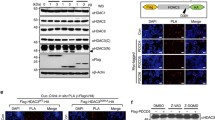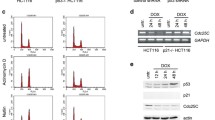Abstract
The p53 oncosuppressor protein is subject to negative regulation by MDM2, which efficiently inhibits its activity through an autoregulatory loop. In response to stress, however, p53 undergoes post-translational modifications that allow the protein to escape MDM2 control, accumulate, and become active. Recent studies have shown that, following DNA damage, the HIPK2 serine/threonine kinase binds and phosphorylates p53, inducing p53 transcriptional activity and apoptotic function. Here, we investigated the role of HIPK2 in the activation of p53 in the presence of MDM2. We found that HIPK2 rescues p53 transcriptional activity overcoming MDM2 inhibition, and that restoration of this p53 function induces apoptosis. Recovery of p53-dependent apoptosis is achieved by preventing p53 nuclear export and ubiquitination mediated by MDM2 in vitro and in vivo following genotoxic stress. These results shed new light on the mechanisms by which the HIPK2/p53 pathway promotes apoptosis and suppression of tumorigenesis.





Similar content being viewed by others
References
Appella E and Anderson CW . (2001). Eur. J. Biochem., 268, 2764–2772.
Barak Y, Juven T, Haffner R and Oren M . (1993). EMBO J., 12, 461–468.
Bulavin DV, Saito S, Hollander MC, Sakaguchi K, Anderson CW, Appella E and Fornace AJ . (1999). EMBO J., 18, 6845–6854.
Chen J, Wu X, Lin J and Levine AJ . (1996). Mol. Cell. Biol., 16, 2445–2452.
Chene P . (2003). Nat. Rev. Cancer, 3, 102–109.
Craig AL, Burch L, Vojtesek B, Mikutowska J, Thompson A and Hupp TR . (1999). Biochem. J., 342, 133–141.
D'Orazi G, Cecchinelli B, Bruno T, Manni I, Higashimoto Y, Saito S, Gostissa M, Coen S, Marchetti A, Del Sal G, Piaggio G, Fanciulli M and Soddu S . (2002). Nat. Cell Biol., 4, 11–19.
Di Stefano V, Rinaldo C, Sacchi A, Soddu S and D'Orazi G . (2004). Exp. Cell Res., 293, 311–320.
Eymin B, Gazzeri S, Brambilla C and Brambilla E . (2002). Oncogene, 21, 2750–2761.
Freedman DA and Levine AJ . (1998). Mol. Cell. Biol., 18, 7288–7293.
Fuchs SY, Fried VA and Ronai Z . (1998). Oncogene, 17, 1483–1490.
Giaccia J and Kastan LB . (1998). Genes Dev., 12, 2973–2983.
Gottlieb TM and Oren M . (1996). Biochim. Biophys. Acta, 1287, 77–102.
Haupt Y, Barak Y and Oren M . (1996). EMBO J., 15, 1596–1606.
Haupt Y, Maya R, Kazaz A and Oren M . (1997). Nature, 387, 296–299.
Hofmann TG, Moller A, Sirma H, Zentgraf H, Taya Y, Droge W, Will H and Schmitz ML . (2002). Nat. Cell Biol., 4, 1–10.
Jones SN, Roe AE, Donehower LA and Bradley A . (1995). Nature, 378, 206–208.
Kim E-J, Park J-S and Um S-J . (2002). J. Biol. Chem., 277, 32020–32028.
Kubbutat MH, Jones SN and Vousden KH . (1997). Nature, 387, 299–303.
Lakin ND and Jackson S . (1999). Oncogene, 1, 7644–7655.
Leite KR, Franco MF, Srougi M, Nesrallah LJ, Nesrallah A, Bevilacqua RG, Darini E, Carnalho M, Meirelles MI, Santana I and Camara-Lopes LH . (2001). Mod. Pathol., 12, 428–436.
Lu H and Levine AJ . (1995). Proc. Natl. Acad. Sci. USA, 92, 5154–5158.
Miyashita T and Reed JC . (1995). Cell, 80, 293–299.
Moll UM, Riou G and Levine AJ . (1992). Proc. Natl. Acad. Sci. USA, 89, 7262–7266.
Momand J, Jung D, Wilczynski S and Niland J . (1998). Nucleic Acid Res., 26, 3453–3459.
Momand J, Zambett GP, Olson DC, Gorge D and Levine AJ . (1992). Cell, 69, 1237–1245.
Montes de Oca Luca R, Wagner DS and Lozano G . (1995). Nature, 378, 203–206.
Oda E, Ohki R, Murasawa H, Nemoto J, Shibue T, Yanashita T, Tokino T, Taniguchi T and Tanaka N . (2000a). Science, 288, 1053–1058.
Oda K, Arakawa H, Tanaka T, Matsuda K, Tanikawa C, Mori T, Nishimori H, Tamai K, Tokino T, Nakamura Y and Taya Y . (2000b). Cell, 102, 849–862.
Oliner JD, Kinzler KW, Meltzer PS, George DL and Vogelstein B . (1992). Nature, 358, 80–83.
Picksley SM and Lane DP . (1993). BioEssay, 15, 689–690.
Polsky D, Bastian BC, Hazan C, Melzer K, Pack J, Houghton A, Busan K, Cordon-Cardo C and Osman I . (2001). Cancer Res., 61, 7642–7646.
Polyak K, Xia Y, Zweir JL, Kinzler KW and Vogelstein B . (1997). Nature, 389, 300–305.
Prives C . (1998). Cell, 95, 5–8.
Prives C and Hall PA . (1999). J. Pathol., 187, 112–126.
Roth J, Dobbelstein M, Freedman DA, Shenk T and Levine AJ . (1998). EMBO J., 17, 554–564.
Sakaguchi K, Saito S, Higashimoto Y, Roy S, Anderson CW and Appella E . (2000). J. Biol. Chem., 275, 9278–9283.
Shieh S-Y, Ikeda M, Taya Y and Prives C . (1997). Cell, 9, 325–334.
Siliciano JD, Canman CE, Taya Y, Sakaguchi K, Appella E and Kastan MB . (1997). Genes Dev., 11, 3471–3481.
Tao W and Levine AJ . (1999). Proc. Natl. Acad. Sci. USA, 96, 3077–3080.
Unger T, Juven-Gershon T, Moallem E, Berger M, Vogt Sionov R, Lozano G, Oren M and Haupt Y . (1999). EMBO J., 18, 1805–1814.
Unger T, Nau MM, Segal S and Minna JD . (1992). EMBO J., 11, 1383–1390.
Valculescu VE and El Deiry WS . (1996). Clin. Chem., 42, 858–868.
Vogt Sionov R and Haupt Y . (1999). Oncogene, 18, 6145–6157.
Vousden KH . (2000). Cell, 103, 691–694.
Wang Y, Bedatin K-M and Hug H . (2001). BMC Mol. Biol., 2, 8–16.
Wu X, Bayle JH, Olson D and Levine AJ . (1993). Genes Dev., 7, 1126–1132.
Acknowledgements
This work was supported by grants from Associazione Italiana Ricerca sul Cancro (AIRC), Ministero Sanità, FIRB, MIUR-CNR, and MIUR Fondi Ateneo. We gratefully acknowledge constructive criticisms and helpful discussion by Dr F Moretti, Dr S Bacchetti, and Dr A Porrello.
Author information
Authors and Affiliations
Corresponding author
Rights and permissions
About this article
Cite this article
Stefano, V., Blandino, G., Sacchi, A. et al. HIPK2 neutralizes MDM2 inhibition rescuing p53 transcriptional activity and apoptotic function. Oncogene 23, 5185–5192 (2004). https://doi.org/10.1038/sj.onc.1207656
Received:
Revised:
Accepted:
Published:
Issue Date:
DOI: https://doi.org/10.1038/sj.onc.1207656
- Springer Nature Limited
Keywords
This article is cited by
-
Exosomal miR-1260b derived from non-small cell lung cancer promotes tumor metastasis through the inhibition of HIPK2
Cell Death & Disease (2021)
-
HIPK2 suppresses tumor growth and progression of hepatocellular carcinoma through promoting the degradation of HIF-1α
Oncogene (2020)
-
PARP1 regulates the protein stability and proapoptotic function of HIPK2
Cell Death & Disease (2016)
-
The beneficial effect of Zinc(II) on low-dose chemotherapeutic sensitivity involves p53 activation in wild-type p53-carrying colorectal cancer cells
Journal of Experimental & Clinical Cancer Research (2015)
-
Different Functions of HIPK2 and CtBP2 in Traumatic Brain Injury
Journal of Molecular Neuroscience (2013)




